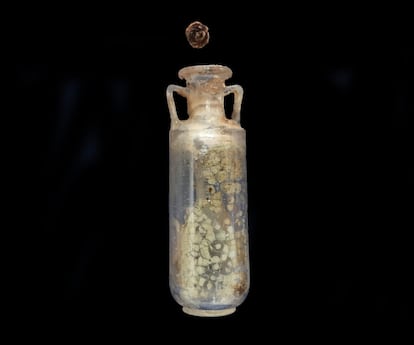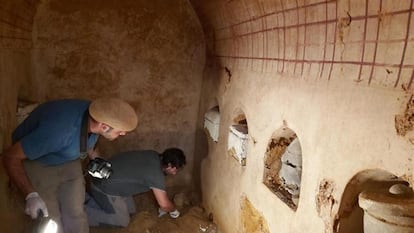Researchers discover what a perfume from Ancient Rome smelled like: patchouli
For the first time, Spanish scholars at the University of Córdoba have managed to analyze a perfume from Ancient Rome, determining its fragrance and chemical composition


Carmona is a town that lies in southwestern Spain, in the province of Seville. Between the first and second centuries A.D., it was one of the main municipalities of the Roman province of Betica, exhibiting the same buildings, institutions and customs as any great city within the empire.
Today, Carmona still preserves outstanding archaeological remains from that time, including the largest funerary complex in the Iberian Peninsula. The survival of these millennial vestiges drew special attention in 2019, during the renovation of a building on the main road. Beneath the structure, a family mausoleum was found, with six occupied niches, or spaces for urns: three for men and three for women. Inside them, numerous funerary offerings were discovered, including a delicate little bottle carved from quartz crystal, with a solid mass inside.
Researchers from the University of Córdoba have now analyzed the composition within the crystal bottle. It’s the first time that the smell of a Roman perfume — made 2,000 years ago — has been identified with scientific accuracy. The university, in an informative note, is concise: “The Romans smelled of patchouli.”
While inspecting the burial chamber of the mausoleum — which is decorated with paintings — eight niches were found “in magnificent condition,” although two of them were never used. It has also been verified that the space was never looted. Inside each niche, various objects — related to funeral rituals and offerings — were found, such as cremated bones, the remains of a cloth bag, three amber beads and an egg-shaped lead box, inside of which the solidified ointment was found. This was the scented offering that someone had placed in the niche of a woman who, when she died, was aged around 40.
The study, titled “Archaeometric Identification of a Perfume from Roman Times,” has been published in the Swiss scientific journal Heritage. It is co-authored by experts Daniel Cosano, Juan Manuel Román, Fernando Lafont and José Rafael Ruiz Arrebola. “Quartz vessels were very rare luxury items,” the paper reads. “Typically, they were not carved, but [formed with heat]. The vessel was, therefore, a rather unusual archaeological find… and even more unusual was that it was hermetically sealed and had a solid mass inside. This provided a unique opportunity to determine the chemical composition of the substances in this high-quality perfume or cosmetic bottle.”
The specialists recall that, although the finding is rare, there have been other such cases, such as two small bottles found in London and Naples — but with animal fat inside — as well as a perfume found in Egypt that was 5,000 years old. “The Egyptians thought that perfume came from Ra, the sun god. From ancient Egypt, perfumes spread to other places like Greece and, later, Rome. The Romans only began to appreciate perfumes after the conquest of the eastern fringe of the Mediterranean,” the authors write.

Fragrances were produced on a large scale during the Roman Empire. The physician Pedanio Dioscórides Anazarbeo (40-90 A.D.) compiled several recipes with aromatic oils, which were used for both perfumes and medicines, while the writer Pliny the Elder (23-79 A.D.) described how to make them. According to the latter, perfumes or ointments had to contain a liquid part and a solid part. Coloring agents could also be added, to make them more attractive to the eye.
The oils most used by the Romans were those extracted from sesame, horseradish, almonds or, especially, from olives. This ingredient had to be extracted from green olives, since they resist oxidation better than ripe ones. In any case, the experts from the University of Córdoba point out, “the recipes detailed by the classical authors were very vague or confusing, regarding the proportions of the components and the procedures for making them.”
The Romans used perfumes not only in daily life, but also on special occasions such as funerals, where incense was mandatory. In addition, the fragrances were also used as ointments when embalming the deceased. When a corpse was cremated, the bones and ashes were kept in an urn together with somewhat expensive perfumes, which were preserved in metal, glass, ceramic or rock containers, depending on the wealth of the deceased, or the support from their relatives, heirs and friends.
To identify the substance inside the Carmonan vessel and the material with which it was made, the specialists carried out multi-analytical and archaeometric studies. The report reads that this included various instrumental techniques, such as X-ray diffraction (XRD), scanning electron microscopy, dispersion X-ray spectroscopy (SEM-EDS), micro-Raman (Raman) and Fourier-transform infrared (FT-IR) spectroscopies, as well as gas chromatography-mass spectrometry (GC-MS).
Detailed analysis reveals that the vessel was made out of a limestone called dolomite and sealed with bitumen, which allowed the state of conservation to be “magnificent.” Regarding the perfume — and as recommended by Pliny — two components were used: a base or binder, which facilitated the preservation of the aromas and the essence. In this case, the base was vegetable oil, possibly olive.
And the essence? According to the analytics, “[the Romans] smelled of patchouli.” This essential oil was obtained from a plant of Indian origin — Pogostemon cablin (also known as stink weed, or pucha pot) — which is widely used in contemporary perfumery, but was not common in the Roman era. This was a very difficult element to obtain at the time of the death of the woman, which shows that she belonged to a high social class.
Sign up for our weekly newsletter to get more English-language news coverage from EL PAÍS USA Edition
Tu suscripción se está usando en otro dispositivo
¿Quieres añadir otro usuario a tu suscripción?
Si continúas leyendo en este dispositivo, no se podrá leer en el otro.
FlechaTu suscripción se está usando en otro dispositivo y solo puedes acceder a EL PAÍS desde un dispositivo a la vez.
Si quieres compartir tu cuenta, cambia tu suscripción a la modalidad Premium, así podrás añadir otro usuario. Cada uno accederá con su propia cuenta de email, lo que os permitirá personalizar vuestra experiencia en EL PAÍS.
¿Tienes una suscripción de empresa? Accede aquí para contratar más cuentas.
En el caso de no saber quién está usando tu cuenta, te recomendamos cambiar tu contraseña aquí.
Si decides continuar compartiendo tu cuenta, este mensaje se mostrará en tu dispositivo y en el de la otra persona que está usando tu cuenta de forma indefinida, afectando a tu experiencia de lectura. Puedes consultar aquí los términos y condiciones de la suscripción digital.
More information
Archived In
Últimas noticias
Petro claims the ELN was the target of US attack in Venezuela
Maduro counterattacks Trump with rhetoric and announces downing of nine drug trafficking aircraft
‘Ecce Homo’: The miraculous disaster that made a small Spanish town famous
Return to sex testing at the Olympics: IOC edges closer to banning transgender women
Most viewed
- Sinaloa Cartel war is taking its toll on Los Chapitos
- Oona Chaplin: ‘I told James Cameron that I was living in a treehouse and starting a permaculture project with a friend’
- Reinhard Genzel, Nobel laureate in physics: ‘One-minute videos will never give you the truth’
- Why the price of coffee has skyrocketed: from Brazilian plantations to specialty coffee houses
- Silver prices are going crazy: This is what’s fueling the rally










































